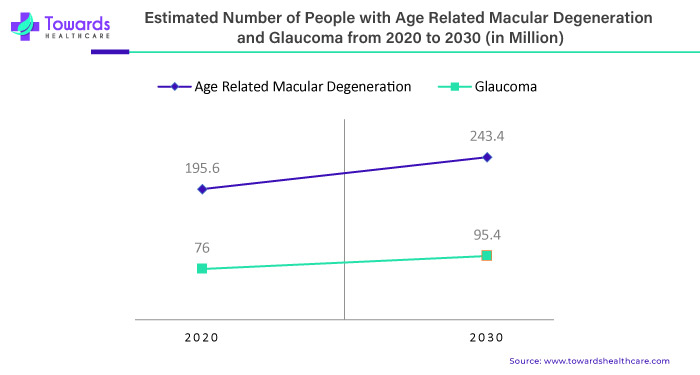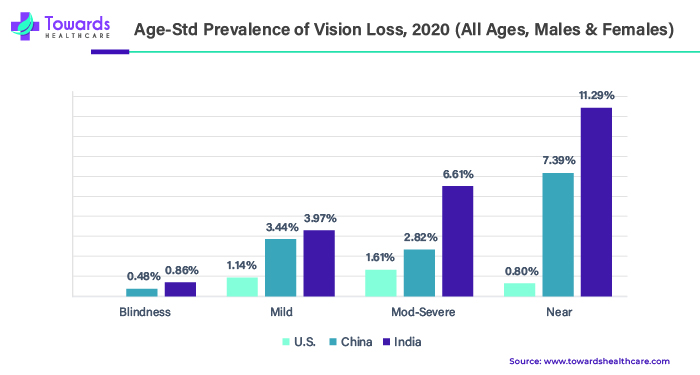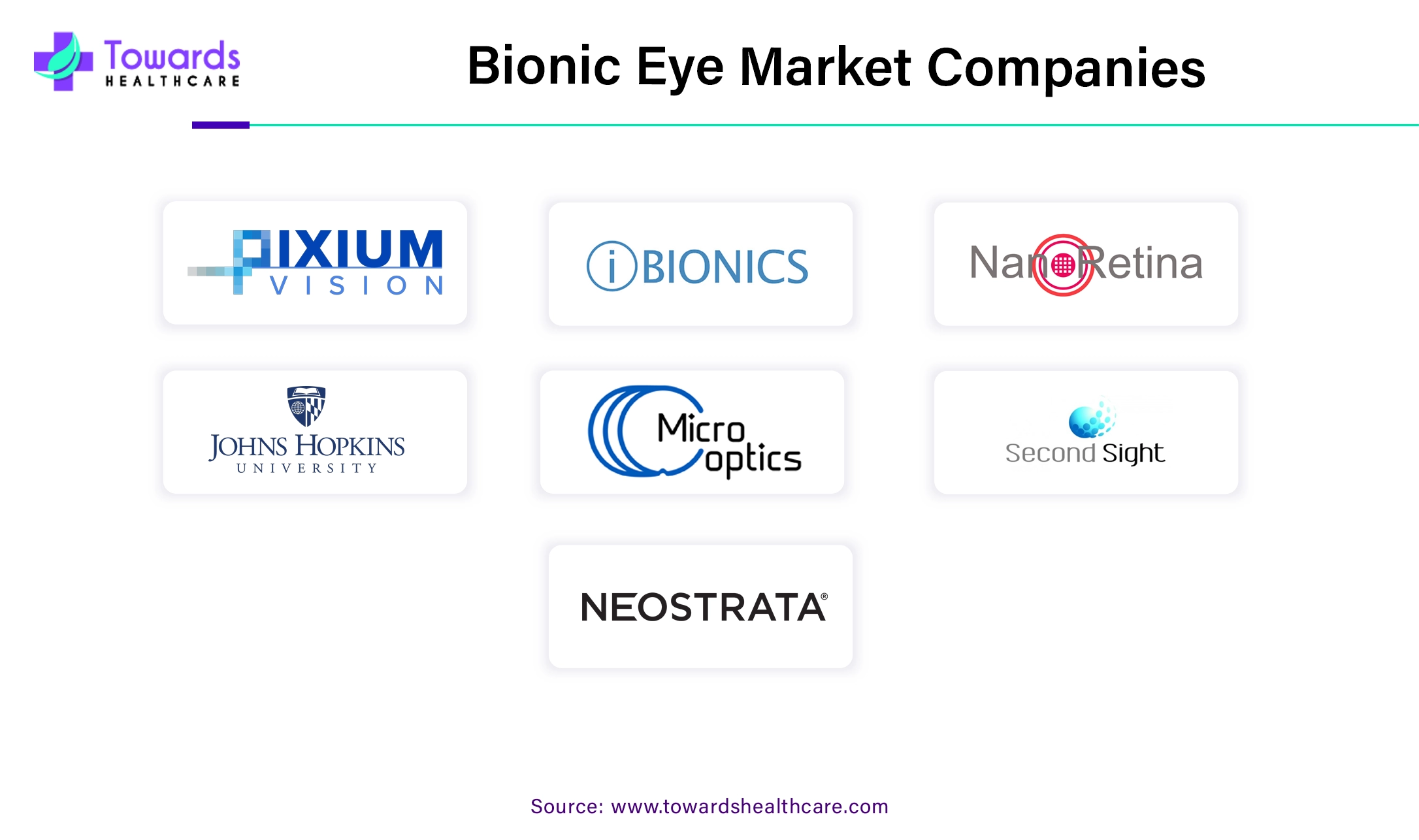November 2025

The global bionic eye market size is calculated at USD 109.06 million in 2024 and is expected to be worth USD 255.59 million by 2034, expanding at a CAGR of 8.89% from 2024 to 2034, as a result of the rising blind population and growth in technological advancements.

An estimated 1 billion people worldwide having a near or distant vision impairment may have been avoided or has yet to be addressed.
The bionic eye market holds extreme potential and growth opportunities in upcoming years if bionic eyes will be made affordably available to the general public and if production scalability is improved. With the currently available technology, prosthetic eyes can potentially serve some aesthetic solutions to the blind population. But if the prices of production and implantation of bionic eyes go down to some extent, it can definitely replace prosthetic eyes with bionic eyes. The replacement of bionic eyes with prosthetic eyes is only possible if prices are reduced, surgical safety and long-term effects are improved, and patient access to such care improves. Our market sizing for bionic eyes is complexly based on these trends considering market potential of prosthetic eyes.
Ophthalmologic conditions are medical conditions that affect the eyes and the structures that surround them. These diseases can impact vision, eye health, and overall health. Refractive errors, age-related macular degeneration, glaucoma, cataracts, diabetic retinopathy, corneal disease, and dry eyes are some of the major ophthalmologic conditions. According to a study in 2019, around 19.83 million Americans suffered from some age-related macular degeneration. For people aged 50 and older, ADM is one of the leading causes of vision loss in North America.
As stated by the National Library of Medicine, according to detailed estimates, 200 million individuals globally have AMD, which is anticipated to increase to nearly 300 million by 2040. Rising tendencies like this are expected to affect 5.4 million Americans by 2050. In addition, according to the WHO’s August 2023 estimates, cataracts and refractive errors are the leading causes of blindness and vision impairments globally. Only 17% of cataract patients have received sufficient access to proper interventions.

In addition, according to the CDC’s November 2020 estimates, glaucoma affects around 3 million individuals in North America. Glaucoma damages optic nerves in the eyes and is one of the leading causes of blindness worldwide. Furthermore, according to the National Library of Medicine, the number of diabetic retinopathy individuals in North America is projected to reach 16.0 million by 2050, with vision-threatening problems impacting approximately 3.4 million of them.
Ophthalmic conditions are the major driving force behind the growth of the bionic eye market. The global prevalence of such ophthalmologic conditions is significantly increasing due to the increasing diabetic population, rising ageing population, and advancements in diagnostics. This ultimately corresponds to an increasing number of patients seeking options for vision restoration. Traditional treatments such as eyeglasses, medicine, and surgery are either unsuccessful or provide little relief for many of these disorders. Bionic eyes are a potential option for recovering some level of eyesight and improving quality of life. As the prevalence of these disorders rises, and technology progresses, bionic eyes are likely to become more effective and accessible, providing hope and a better quality of life for millions of individuals who are blind.
AI-driven image processing algorithms stand at the forefront of revolutionizing bionic eyes. By increasing the interpretability and quality of images captured by bionic eye cameras, these algorithms promise an additional realistic and detailed visual experience for end-users, breaking down obstacles to perception. The integration of AI with bionic eyes also includes the creation of focused and effective stimulation algorithms. These AI-based algorithms have the impending to enhance resolution, broaden the field of view, and lessen the energy footprint of bionic eyes, which causes growth of the bionic eye market.
Ocular implants, small devices placed into the eye and releasing medicine locally over time, are gaining popularity as a modern treatment choice. As patients look for more convenient, less painful therapies, the market for these implants will expand. Ophthalmic implants are a swiftly expanding area of ophthalmology that provides potential therapies for various eye illnesses and conditions. These implants are intended to repair or enhance the function of injured or diseased ocular structures, thereby restoring or improving vision.
Ophthalmic implants are emerging as a breakthrough technique in ophthalmology, providing a ray of hope to millions of people suffering from vision loss caused by various diseases and traumas. Their influence extends beyond vision repair to research and define the future of vision restoration. Several ophthalmic implants include intraocular lenses, orbital implants, retinal implants, glaucoma implants, corneal implants, and others.
In addition, ophthalmic implants have the ability to enhance patient outcomes by resorting vision impairments. The rising implementation of intraocular lenses in cataracts, restoring vision and presbyopia, improves the quality of life for patients suffering from ocular disorders. Chronic conditions such as glaucoma extensively require ocular implants to limit vision loss and manage intraocular pressure. The rise in product launches and the adoption of advanced technology also foster market growth.
For Instance,
Furthermore, the rising prevalence of ocular illnesses such as cataracts, glaucoma, and age-related macular degeneration (AMD) is a growing demand for ophthalmic implants. An older population and increased knowledge of these problems contribute to market expansion. The recent shift toward personalized treatment options is helping to develop custom ocular implants matched to particular patient needs and anatomical characteristics.
Individuals who have lost an eye rely heavily on prosthetic eyes for their bodily and mental well-being. They provide functional benefits such as socket lubrication & protection and improved appearance and self-confidence. Prosthetic eyes are anticipated to grow more technologically advanced as technology progresses, providing greater patient benefits. On the other hand, vision cannot be restored with a prosthetic eye.
A person will have no vision in that eye when the natural eye is removed and replaced with a prosthetic eye. The demand for prosthetic eyes is on the rise as eye disorders such as glaucoma, macular degeneration, and diabetes-related retinopathy have grown more common. These disorders frequently include the removal or partial removal of the eye, creating the need for artificial alternatives.
However, the cultural stigma associated with vision loss is decreasing, and more individuals are understanding the positive aspects and enhanced level of life that prosthetic eyes can provide. This increased awareness augments the demand for such devices.
In addition, the creation of prosthetic eyes is dramatically evolving with technological improvements. Innovations like 3D printing, advanced design techniques & materials, and personalization in artificial eyes are paving the way for more comfortable and natural-looking ocular prosthetics. Patients considering prosthetic eyes are more concerned about their aesthetic appearance. They desire solutions as close to their natural eyes as possible, which drives the need for customized and high-quality prostheses. Furthermore, prosthetic eyes are becoming increasingly accessible to a broader spectrum of patients due to stronger healthcare infrastructure in developing nations, along with favourable reimbursement rules in certain areas. This broadens the market and makes these products more accessible to more individuals.
Moreover, prosthetic eyes are in high demand in developing nations. Growing awareness and greater spending power in these regions create major growth potential for the market. Thus, rising eye disorders, more awareness, technical improvements, and an emphasis on aesthetics are driving the expansion of the prosthetic eye industry. As technology progresses and awareness grows, we can expect this market to expand steadily in the coming years.
The bionic eye is an electrical prosthetic surgically inserted into a human eye to allow light transmission in persons who have suffered serious retinal loss. The bionic eye comprises an exterior camera, transmitter, and an internal microprocessor. The camera is installed on spectacles, organising environmental visual stimuli before generating high-frequency radio waves. In 2012, the first-ever fundamental bionic eye was inserted into a patient suffering from vision loss due to retinitis pigmentosa.
Bionic Vision Australia, an Australian firm, manufactured the first model. Since then, technological advances have been applied in updated versions implanted in individuals whose eyesight has been damaged by retinitis pigmentosa. The most well-known retinal prosthesis is the Argus II, the first approved bionic eye for its use in the U.S. and Europe.
In addition, the rising focus on R&D in this field is projected to generate promising solutions for patients with vision loss and opportunities for the market players. For instance, In October 2021, IMIE 256 (256 Channel Intelligent Micro Implant Eye) was studied and evaluated for its efficacy and safety by comparing it with an Argus II implant. The results demonstrated an enhanced safety and effectiveness profile compared to the Argus II implant. More clinical trials with a larger number of patients and for longer periods of time are required to corroborate these findings.
Furthermore, the majority of bionic eyes currently under development are for people suffering from retinal degeneration caused by diseases such as retinitis pigmentosa (RP) and age-related macular degeneration (AMD).

According to the WHO’s August 2023 estimates, at least 2.2 billion people worldwide have a near or far vision impairment. Vision impairment might have been avoided or is still being addressed in at least 1 billion of these cases.
The bionic eye is a ray of hope for people with significant visual loss, allowing them to navigate a previously unclear world. It opens the door to fresh independence, allowing them to move confidently, avoid barriers, and accomplish daily duties easily. This restored ability to view the world correlates to more excellent social relationships, as they can now read emotions on faces and engage in meaningful visual communication. Perhaps most crucially, the bionic eye ignites the spark of self-confidence and well-being, allowing individuals to restore a sense of agency and control over their lives.
Moreover, the increasing incidence of eye disorders such as glaucoma and macular degeneration produces a surge in demand for vision restoration, while technical advances ride along with it. Innovative electrode materials, better stimulation techniques, and even AI integration are boosting bionic eyes' performance and potential. The societal stigma associated with vision loss is fading, and this life-changing technology is becoming more widely known and accepted. Finally, advances in surgical techniques and expanded insurance coverage make bionic eye surgeries more accessible, paving the path for a future in which vision loss is no longer a barrier.
Bionic eye technology is being developed further, including breakthroughs in electrode materials, stimulation techniques, and integration with AI. Bionic eyes have the potential to significantly improve the lives of those who have lost their vision by allowing them to perceive the world in new ways. The bionic eye market is promising, providing a glimpse into a future where vision loss is less of a barrier. However, additional efforts are required to remove obstacles and enable equitable access to this life-changing technology.
The high cost of bionic eyes limits the market growth. Creating bionic eyes is so costly as it includes its research and development, implantation, surgical procedure, and post-surgical care costs. The research and development of bionic eyes have taken several years as it is technologically very crucial to develop an artificial eye resembling and functioning like a human eye. The implantation of a bionic eye is an extremely technical and delicate procedure that requires specific medical equipment and highly skilled surgeons, which accelerates the overall cost of bionic eye implantation. These factors are majorly boosting the cost and restraining the market growth.
In addition, even though the bionic eye is a ray of hope for millions of people across the globe, the technology hasn’t been a complete solution as an eye replacement; current technology can restore the darkness to some extent but achieving complete normal vision for blinds is still a dream.
Furthermore, even if there is a large diseased population, the high costs of bionic eyes limit its access to them, especially in low-income and middle-income countries. The affordability constraints exclude several people who could benefit from the bionic eye. Many people who could benefit from the bionic eye are unable to afford it, particularly those in low- and middle-income nations. This generates a large access gap and poses questions regarding equity and ethics. Moreover, the bionic eye requires sufficient pre-operative and post-operative care, and continuous monitoring further elevates the cost of the bionic eye treatment.
By type, the external eye segment dominated the bionic eye market in 2023. External eye components include glasses, tiny computers, and power supplies. These components aid in processing light for patients with vision loss. Patients having anxiety about surgically implanting a material prefer mostly external eyes.
By type, the implanted eye segment will gain a significant share of the market over the studied period. Implanted eyes are placed on the retina surface, allowing for signals to be sent to the brain directly. The major component of an implanted eye includes a microchip. The latest innovations to develop implanted eyes using novel materials to avoid immune reactions drive the segment’s growth.
By technology, the electronic segment held a dominant presence in the market in 2023. The electronic components include a camera, processor, radio frequency coil, electrode, and microchip. Ongoing innovations in microelectronics and neuroengineering potentiate the segment’s growth.
By technology, the mechanical segment is anticipated to grow with the highest CAGR in the market during the studied years. Mechanical bionic eyes depend on physical mechanisms to mimic natural eye functions. Mechanical components include cameras, transmitters, and microchips. Utilizing mechanical technology in bionic eyes increases its aesthetic appearance and ease of use.
By indication, the vision loss and impairment segment held the largest share of the market in 2023. The rising incidences of vision loss and impairment cases globally and increasing awareness for bionic eyes boost the segment’s growth. According to the WHO, at least 2.2 billion people worldwide currently have vision impairment, out of which 36% is due to refractive error and 17% is due to cataracts. Also, vision impairment poses a significant global financial burden, with the annual global cost of productivity estimated to be $411 billion. This demands adopting bionic eyes to reduce financial burden.
By indication, dry age-related macular degeneration segment is projected to expand rapidly in the market in the coming years. The rising geriatric population and increasing cases of age-related macular degeneration (AMD) boost the segment’s growth. AMD is the leading cause of vision loss in people 55 years and above and is responsible for 6-9% of cases of legal blindness worldwide.
By end-use, the hospital segment registered its dominance over the global bionic eye market in 2023. The increasing number of patients in hospitals, suitable infrastructure, availability of instruments, and the presence of multidisciplinary experienced professionals augment the segment’s growth. Hospitals also have sufficient capital investment to adopt cutting-edge technologies.
By end-use, the ophthalmic clinic segment is expected to grow at the fastest rate in the market during the forecast period. Ophthalmic clinics contain specialized instruments and specialized trained professionals to guide the patients and provide effective treatment.
The North America bionic eye market holds a significant market share due to strong healthcare infrastructure and the presence of market players like Second Sight Medical Products, which are actively involved in developing advanced and effective bionic eyes. The rising incidences of vision loss, increasing investments, and favorable government initiatives also drive the market. The National Eye Institute by the National Institute of Health invested $863 million in 2022 and $896 million in 2023 for various research projects and grants related to eye disorders. The Centers for Disease Control and Prevention (CDC) reports that more than 3.4 million Americans above 40 years are blind or visually impaired and expects the number to double by 2030.
Additionally, the Vision Health Initiative (VHI) by CDC promotes vision health and quality of life for all populations through preventing and controlling eye disease, eye injury, and vision loss. In addition, the Asia Pacific region offers extensive growth opportunities as an emerging powerhouse with a vast population struggling with visual impairments and a rising prevalence of ocular disease conditions. The growing research and development in the region, technological advancements, and government initiatives to prevent vision loss boost the market.

The bionic eye market is challenging and varied, with tremendous potential and significant difficulties in several countries. We can strive toward a future where bionic eyes illuminate lives and empower those with visual loss worldwide by understanding each area's specific strengths and challenges, enabling collaboration, and addressing ethical concerns.
Dr. Diane Hilal-Campo, New Jersey-based ophthalmologist, shared her views on the bionic eye that technological advancements have been redefining ophthalmology. She also added that the latest innovations have made diagnosis more precise and transformed patient care for the better.

By Type
By Technology
By End Users
By Geography
November 2025
November 2025
November 2025
November 2025